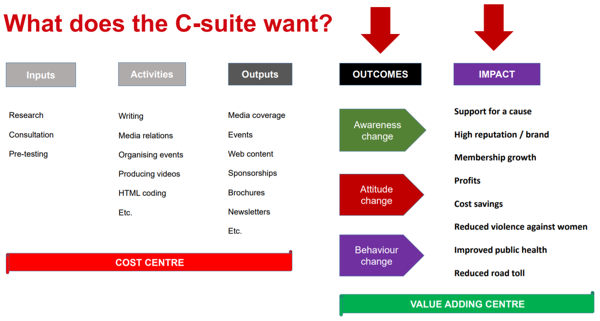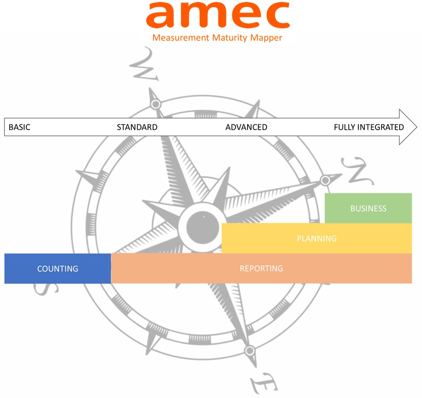The arc of innovation for communication measurement accelerates
PR News
Ben Smith
I attended something like my seventh AMEC conference recently. The measurement of public relations is one of the top priorities for PR and comms professionals so it’s been interesting to observe the sector over a fairly prolonged period.
I won’t attempt a history lesson of PR measurement here but huge progress has been made. What came out of this conference, for me, was that the automated measurement that has been building its reliability for the best part of the last 10 years, has made big strides in its reliability in the last 12 months.
Signal Media founder David Benigson says that its “automated media evaluation now performs to 98% accuracy levels.”
That said, Kantar Media’s Marcus Gault believes that “AI and automated measurement is the next vital step for measurement because of their key advantages of speed, lower cost and the ability to integrate and analyse wider data sets. From a reliability perspective AI measurement is not yet board ready.”
If anyone is still searching for the silver bullet of PR measurement, Jim Macnamara, the hugely respected Distinguished Professor of Public Communication, University of Technology Sydney, reminds us that “There isn’t one magic number, the best insights come from the triangulation of data”.
Here are my top takeaways from AMEC 2018:
Measure all appropriate channels
Think about the data sets that matter to your customer journey when considering your measurement proposition. This will likely include media, social media and a number of digital data sets from advertising to customer data.
So consider your customer’s journey and link your measurement and your measurement KPIs to that. Most PRmoment readers will be familiar with AMECs integrated framework but if not it’s an excellent guide to what measurement KPIs to use depending the channel and your objectives.
2. If you are only measuring your communication outputs your board will see you as a cost centre
If you are measuring communication outcomes and communication impact they will see you as a profit centre.
As described in this slide from Professor Jim Macnamara when discussing a UK government campaign to reduce road deaths.

Macnamara suggested the following four examples of high end evaluation:
Social network analysis (SNA) and social influencer mapping
Behavioural insights
− From behavioural economics / behavioural psychology
Net Promoter Score (NPS)
− Closed loop methodology (Reichheld and Bain & Company)
Customer journey mapping
− Customer decision journey (McKinsey)
3. The measurement tool and measurement consultancy market is changing
There are a raft of new suppliers in this sector. Alongside media monitoring/evaluation firms like Kantar and Pressdata you’ve got new entrants like Signal and Newton in the UK. Then from a social listening perspective you’ve got a great British success story Brandwatch (the dominant player in this market) up against the likes of Ubermetrics and Talkwalker.
On the digital earned media space Trendkite offer a digital attribution solution and then there is Cision who have invested heavily to try and create an integrated multi channel approach across measurement and distribution.
So there is lots going on tool wise and no one product is right for everyone.
A lot of the feedback I get from in-house and agency people is that it’s very difficult to gauge which tools work and which tools don’t. If I were looking to buy one of these services a peer recommendation would reassure me and PRmoment continues to review as many of these tools as we can. In addition, many of the suppliers offer trials of their products.
It may be worth taking advantage of these before entering into a long term contract.
4. UK Government Communications Service Evaluation Framework 2.0.
UK government comms supremo Alex Aitken launched its latest Evaluation Framework 2.0. It's a seriously impressive piece of work and well worth a read whatever stage of your measurement journey you may be on.
5. AMEC launches its M3 initiative
The AMEC Measurement Maturity Mapper is a tool designed to provide organisations with a clear idea of where they are on their measurement and evaluation journey. It provides a benchmark against the average of similar organisations and includes specific recommendations on how organisations can develop and enhance their evaluation program.
The evolution of a company’s measurement and evaluation journey:

A diagnostic self-assessment has been developed which drives the report output and will be available to all communications and measurement professionals from the AMEC website later in November this year.
If you enjoyed this article, you can subscribe for free to our weekly event and subscriber alerts.
Featured

PR professionals share their views on journalists publicly calling them out on story pitches

Auto blogger renders unconditional apology to Value 360 for defamatory posts

Hottest Indian startups of 2020, Paytm, Dreams 11 lead the charge: Wizikey Report




